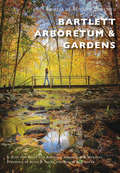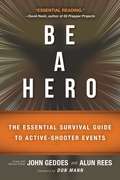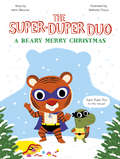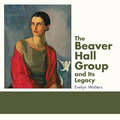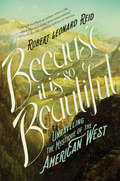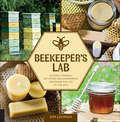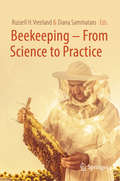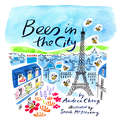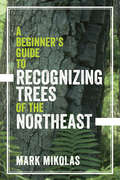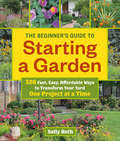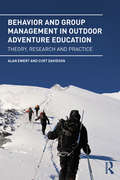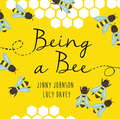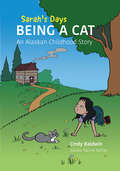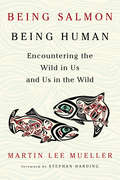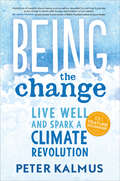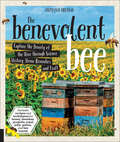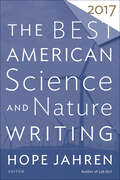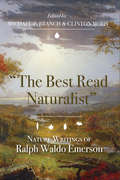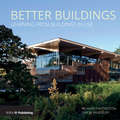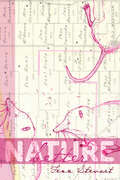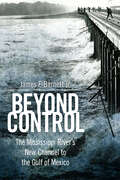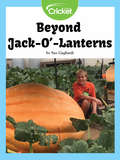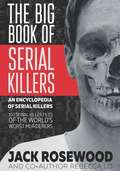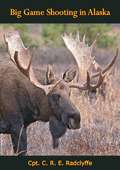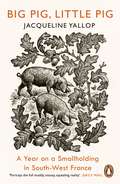- Table View
- List View
Bartlett Arboretum & Gardens (Images of Modern America)
by Bartlett Arboretum Gardens Foreword By Smith Hilary B. Forsyth S. Jane TrappBartlett Arboretum & Gardens follows the history of this exquisite Stamford, Connecticut, gem from its genesis as a tree research lab and a training school for arborists to today’s 93 acres of irreplaceable open space. It highlights the best of what Connecticut’s native landscape has to offer: magnificent award-winning champion trees, charming gardens, wildflower meadows, red maple wetlands and boardwalks, woodland walking trails, varied wildlife, and native habitats. As the original home of Francis A. Bartlett, the founder of the F.A. Bartlett Tree Expert Company, the grounds were developed with his favorite trees, including nut trees, small flowering trees, and conifers, from around the world. This is a fascinating story about the passing of the property from Bartlett to the State of Connecticut to the City of Stamford, the hundreds of volunteers who have advocated and toiled to keep the arboretum beautiful and accessible to the public, and the impressive century-old plants.
Be a Hero: The Essential Survival Guide to Active-Shooter Events
by Don Mann John Geddes Alun ReesDealing with the unthinkableIt’s never going to be you. Then one day you hear the clatter of automatic fire at the mall. You have been drawn into the chaos and terror of an active shooter event. What do you do? Who do you turn to? Be a Hero is the essential guide to terrorist attacks that will help you survive. Former Special Air Service terror expert John Geddes will explain how to cope with a life-threatening event. He shows you how to make clear decisions and beat the odds by:Dealing with fear through simple and effective techniques to bring the chemical urges generated by terror at least partially under controlEscaping and evading when possible, using everyday objects and landmarks for protectionFighting back if needed, with methods to disarm an active shooter and to use items at hand as weaponsUsing a weapon if you are licensed to carry, shooting to kill without collateral damage or being mistaken for a perpetratorProviding medical assistance to deal with traumatic battlefield injury and save livesThis is not a book primarily for survivalists and 'preppers.’ Be a Hero is a book for ordinary men and women who could find themselves in the middle of an extraordinary moment. It will help them find the hero inside-and live to tell the tale.
A Beary Merry Christmas (The Super-Duper Duo)
by Henri Meunier Nathalie ChouxRory and Sheldon are just regular guys, going to school, having playdates, and, of course, counting down the days until Christmas. But when a furious bear starts wreaking havok in their calm wood, Rory and Sheldon are there to save the holiday as...the Super-Duper Duo! They use their super-duper powers—and their knowledge about animal hibernation—to calm the crazed carnivore and keep the peace. The Super-Duper Duo books mix zany adventure comics and animal facts in exciting young readers that are both hysterical and informative. Just another mission accomplished for the Super-Duper Duo!
The Beaver Hall Group and Its Legacy
by Evelyn WaltersAn exploration into Montreal’s Beaver Hall Group and its legacy of women painters who now rank among Canada’s most outstanding artists. Today it is difficult to imagine that the art of Montreal’s Beaver Hall Group was once shocking. As these Modernists struggled against academic art, critics such as Samuel Morgan-Powell ranted — “rough,” “meaningless” “blatant plastering and massing of unpleasant colours in weird landscapes” — and likened their paintings to the “cacophonous riot of metallic yowlings” of jazz that was invading the city. Moreover, unlike their contemporaries, the Group of Seven, the Beaver Hall Group dared to break with tradition and accept women members. The result was a legacy of some of the finest women painters Canada has so far produced. In 2005, Evelyn Walters gave them deserved attention in her acclaimed book, The Women of Beaver Hall: Canadian Modernist Painters. Now, a follow-up, The Beaver Hall Group and Its Legacy delves into the engrossing life stories of the twenty-five artists who belonged to the Beaver Hall Group and the Women of Beaver Hall. Over seventy-five images gleaned from museums and private collections highlight the work of these pioneering artists who changed the course of Canadian art. Written for student and scholar alike, The Beaver Hall Group and Its Legacy is a must for every art lover’s library.
Because It Is So Beautiful: Unraveling the Mystique of the American West
by Robert Leonard ReidA Finalist for the PEN/Diamonstein–Spielvogel Award for the Art of the EssayYes, every inch of the globe has been seen, mapped, photographed, and measured, but is it known? Robert Leonard Reid doesn’t think so. To draw a circle and calculate its diameter is not to know the circle. In this collection, Reid distinguishes himself from many science–based nature writers, using the natural world as a springboard for speculations and musings on the numinous and the sacred, injustice, homelessness, the treatment of Native Peoples in the United States, and what pushes mountaineers to climb. Ranging in their settings from eastern New Mexico to northern Alaska, Reid’s essays illustrate his belief that the American West is worth celebrating and caring for.Taking its title from an affecting speech given by renowned author Barry Lopez, Because It Is So Beautiful is a response to desperate questions surrounding America’s wildlands. Lopez’s words resonated with the young mountaineer–musician–mathematician Robert Leonard Reid, who was struggling to understand his relationship to the world, to find his vision as a writer. What he learned on that long–ago evening is knit throughout the nineteen pieces in the collection, which include essays from Reid’s previous books Arctic Circle, Mountains of the Great Blue Dream, and America, New Mexico; three essays that appear here in print for the first time; as well as revised and expanded versions of essays that appeared in Touchstone, The Progressive, and elsewhere.
Beekeeper's Lab: 52 Family-Friendly Activities and Experiments Exploring the Life of the Hive
by Kim Lehman"Very informative and fun . . . Science, art, bee care, 52 different labs to entertain, delight, educate and inspire everyone in your family." —A Net in TimeBeekeeping's popularity as a hobby continues to skyrocket. And now, with Beekeeper's Lab, you can fill the year ahead with weekly activities from around and about the hive—including art projects, recipes, experiments, garden activities, and more!Bees are important to local ecosystems,now more than ever. Whether you're already a beekeeper, or are still considering getting your first hive, Beekeeper's Lab has projects perfect for you. This extensive guide book features 52 beekeeping and hive-inspired projects to keep you involved with your buzzing friends all year long.The tutorials are brief, accomplishable, rewarding, and best of all, they are presented in afriendly lab-style format. Try a new technique each weekwith how-tos and sidebars with tips that are perfect for the whole family. Beekeeping is a fun hobby to enjoy, plus, who doesn't want their own supply of honey?
Beekeeping – From Science to Practice
by Russell H. Vreeland Diana SammataroThis book will help beekeepers understand the fundamentals of beekeeping science. Written in plain and accessible language by actual researchers, it should be part of every beekeeper's library. The respective chapters not only present raw data; they also explain how to read and understand the most common figures. With topics ranging from honeybee nutrition to strains of Varroa resistant bees, from the effects of pesticide chemicals to understanding diseases, and including a discussion of venom allergies, the book provides essential "knowhow" that beekeepers will benefit from every time they inspect their hives. Further, each chapter ends with the author explaining how beekeepers can (or cannot) directly utilize the information to enhance their beekeeping operation. The text is structured to facilitate ease of use, with each author addressing the same four issues: 1) What are the specific purposes or goals of these experiments? Or more simply: what have these studies taught us? 2) How should a non-scientist read the data generated? 3) What are the key points in relation to practicing beekeepers' goals? 4) How can the data or techniques discussed be applied by beekeepers in their own apiaries? This approach allows readers to look up specific information quickly, understand it and even put it to use without having to read entire chapters. Further, the chapters are highly readable and concise. As such, the book offers a valuable guide and faithful companion for all beekeepers, one they can use day in and day out.
Bees in the City
by Andrea Cheng Sarah McMenemy2018 Green Earth Book Award Finalist Lionel lives in a Paris apartment building but loves keeping bees with his Aunt Celine at her farm outside the city. But when her bees start dying, how can he help? The solution, he realizes, is in the rooftop gardens and window boxes of his apartment neighbors, representing a varied and continuously blooming array of flowers that the bees will love. Aunt Celine must bring her bees to Paris! But first he and his friends Alice and Samir must convince their skeptical neighbors and landlord, Mr. Dubi, that this is a good idea. Adorned with Parisian skylines, Bees in the City is a love letter to the City of Light and a celebration of the can-do spirit of kids. Sarah McMenemy’s illustrations recall the Parisian magic of Madeleine. The book’s backmatter explores urban beekeeping and rooftop gardening in greater depth. Fountas & Pinnell Level P
A Beginner's Guide to Recognizing Trees of the Northeast
by Mark MikolasIdentify maple, ash, oak, and more with easy-to-learn visual techniques. In this friendly and approachable field guide, writer and avid hiker Mark Mikolas shares a unique approach for year-round tree identification. His method, which centers on the northeastern United States where 20 species make up the majority of trees, will prepare readers to recognize trees at a glance, even in winter when leaves and flowers are not present. Mikolas’s secret is to focus on the key characteristics of each tree—black cherry bark looks like burnt potato chips; beech and oak trees keep their leaves in winter; spruce needles are pointed while balsam fir needles are soft and rounded at the ends. Some trees can even be identified by scent. Location maps for each of the 40 species covered and more than 400 photographs illustrating key characteristics make the trees easy to identify. Mikolas also explains how to differentiate between similar and commonly confused trees, such as red maple and sugar maple. A Beginner’s Guide to Recognizing Trees of the Northeast is a book to keep close at hand wherever trees grow.
The Beginner's Guide to Starting a Garden: 326 Fast, Easy, Affordable Ways to Transform Your Yard One Project at a Time
by Sally RothA fresh approach and simple way to transform your yard! The prospect of revamping a yard is daunting. Where do you start? How do all the various areas come together in a beautiful, cohesive way? The Beginner’s Guide to Starting a Garden simplifies the process by showing you how to spend fewer hours (and a minimal amount of money) in the garden by tackling one small area at a time. You’ll find garden plans for ten unique areas—the entryway, the shady areas under trees, and more—that can be linked together over time to create a unified yard, and plants that are dependable, easy to find, and look good year after year. You’ll also learn the basics of good design, which plants offer the most bloom for your buck, and how to avoid the most common planting mistakes.
Behavior and Group Management in Outdoor Adventure Education: Theory, research and practice
by Alan Ewert Curt DavidsonOutdoor adventure activities are becoming an increasingly popular part of physical education programs. The physical risks of these activities are often foremost in the minds of both instructors and participants, yet it is managing group behavior which can prove to be the most difficult. This is the first book for students and practitioners to address this essential aspect of outdoor adventure education (OAE). Outlining key evidence-based training practices, this book explains how to interact with groups ranging from adolescents to military veterans within a variety of outdoor adventure education contexts. It provides practical advice on how to promote positive behavior, while also offering guidance on how to mitigate negative behavior and manage a variety of challenging behavioral issues. With ten chapters full of real world examples from rock climbing to wilderness trekking, it provides a comprehensive guide to understanding the complexities of behavioral group management (BGM) in theory and practice. This book is vital reading for students training to be outdoor physical education instructors and for practitioners looking to enhance their group management skills.
Being a Bee
by Jinny JohnsonBuzz into Being a Bee to discover more about this incredible insect.Buzzing from flower to flower, and making delicious honey to eat, bees have endless child appeal. But there's even more to bees than meets the eye... Buzz into Being a Bee to discover more about this incredible insect. Children will love learning about life in the hive, bee families, and how older bees work together to look after and raise baby bees. They can find out about beekeeping, how and why bees make honey, and how they dance to communicate with other bees.The book also gently introduces children to the idea of conservation - explaining why bees are in danger, the need to protect them, and all the ways we can help, from planting wild flowers to buying local honey. Gentle engaging text, and bright, captivating artwork will ensure children finish the book as bee experts!
Being a Cat: An Alaskan Childhood Story
by Cindy BaldwinSarah's Days is a series of picture books written by Cindy Baldwin. Sarah is a curious five-year-old who has different adventures and experiences each day. At the end of the day she goes home to tell her father all about it.
Being Salmon, Being Human: Encountering the Wild in Us and Us in the Wild
by Stephan Harding Martin Lee MuellerIn search of a new story for our place on earth Being Salmon, Being Human examines Western culture’s tragic alienation from nature by focusing on the relationship between people and salmon—weaving together key narratives about the Norwegian salmon industry as well as wild salmon in indigenous cultures of the Pacific Northwest. Mueller uses this lens to articulate a comprehensive critique of human exceptionalism, directly challenging the four-hundred-year-old notion that other animals are nothing but complicated machines without rich inner lives and that Earth is a passive backdrop to human experience. Being fully human, he argues, means experiencing the intersection of our horizon of understanding with that of other animals. Salmon are the test case for this. Mueller experiments, in evocative narrative passages, with imagining the world as a salmon might see it, and considering how this enriches our understanding of humanity in the process. Being Salmon, Being Human is both a philosophical and a narrative work, rewarding readers with insightful interpretations of major philosophers—Descartes, Heidegger, Abram, and many more—and reflections on the human–Earth relationship. It stands alongside Abram’s Spell of the Sensuous and Becoming Animal, as well as Andreas Weber’s The Biology of Wonder and Matter and Desire—heralding a new “Copernican revolution” in the fields of biology, ecology, and philosophy.
Being the Change: Live Well and Spark a Climate Revolution
by Peter Kalmus&“A plethora of insights about nature and ourselves, revealed by one man&’s journey as he comes to terms with human exploitation of our planet.&” —Dr. James Hansen, climate scientist and former director of NASA&’s Goddard Institute for Space Studies Life on one-tenth the fossil fuels turns out to be awesome. We all want to be happy. Yet as we consume ever more in a frantic bid for happiness, global warming worsens. Alarmed by drastic changes now occurring in the Earth&’s climate systems, Peter Kalmus, a climate scientist and suburban father of two, embarked on a journey to change his life and the world. He began by bicycling, growing food, meditating, and making other simple, fulfilling changes. Ultimately, he slashed his climate impact to under a tenth of the US average and became happier in the process.Being the Change explores the connections between our individual daily actions and our collective predicament. It merges science, spirituality, and practical action to develop a satisfying and appropriate response to global warming. Part one exposes our interconnected predicament: overpopulation, global warming, industrial agriculture, growth-addicted economics, a sold-out political system, and a mindset of separation from nature. It also includes a readable but authoritative overview of climate science. Part two offers a response at once obvious and unprecedented: mindfully opting out of this broken system and aligning our daily lives with the biosphere. The core message is deeply optimistic: living without fossil fuels is not only possible, it can be better. &“In this timely and provocative book, Peter Kalmus points out that changing the world has to start with changing our own lives. It&’s a crucial message that needs to be heard.&” —John Michael Greer, author of After Progress and The Retro Future
The Benevolent Bee: Capture the Bounty of the Hive through Science, History, Home Remedies, and Craft
by Stephanie BruneauA beekeeper and herbalist shares how you can use six products of the beehive: honey, pollen, propolis, royal jelly, beeswax, and bee venom. Not all new beekeepers realize that a honeybee hive produces a lot more than just honey. While your hard-working ladies will produce delicious honey, the hive as a whole also produces pollen, propolis, royal jelly, beeswax, and bee venom; all very useful things for humans, if we know how to use them.The Benevolent Bee describes how and why the bees make these products, how they&’ve been used by humans throughout the ages, and how beekeepers can harvest the products. It also presents simple do-it yourself recipes for using the products in health and wellness, body care, nutrition, and craft. You'll learn how to make salves for burns and a cough syrup from raw honey; how to make a tincture, an infused oil, and a mouthwash from propolis, the anti-bacterial &“bee glue&” that lines the inside of the hive; and much more. Get crafting now, it&’s all already in your hive!
The Best American Science And Nature Writing 2017 (The Best American Series)
by Hope Jahren, Tim FolgerTwenty-four “outstanding” pieces of American science & nature writing, edited by a renowned scientist and bestselling author (Publishers Weekly).“Science is both essential and frivolous, jubilant and despairing, lovely and brutal, perfect and broken—all at the same time—just like the scientists who fashion it,” writes Hope Jahren in her introduction to The Best American Science and Nature Writing 2017. The pieces honored in this collection celebrate astonishing wonders—from our public lands to a new way of tasting food we eat—and investigate grave perils, like the rapid progression of climate change, air pollution, and more. They show us the beauty and innovation of our planet, and how urgently we must fight to protect it from all those who take it for granted.The Best American Science and Nature Writing 2017 includes:Elizabeth KolbertDavid EpsteinMaria KonnikovaJon MooallemTom KizziaNicola TwilleyAnd others
The Best Read Naturalist": Nature Writings of Ralph Waldo Emerson (Under the Sign of Nature: Explorations in Ecocriticism)
by Ralph Waldo Emerson Michael P. Branch Clinton MohsRalph Waldo Emerson is one of the most important figures in American nature writing, yet until now readers have had no book devoted to this central theme in his work. "The Best Read Naturalist" fills this lacuna, placing several of Emerson’s lesser-known pieces of nature writing in conversation with his canonical essays. Organized chronologically, the thirteen selections--made up of sermons, lectures, addresses, and essays--reveal an engagement with natural history that spanned Emerson’s career. As we watch him grapple with what he called the "book of nature," a more environmentally connected thinker emerges--a "green" Emerson deeply concerned with the physical world and fascinated with the ability of science to reveal a correspondence between the order of nature and that of the mind. "The Best Read Naturalist" illuminates the vital influence that the study of natural history had on the development of Emerson’s mature philosophy.
Better Buildings: Learning from Buildings in Use
by Richard Partington Simon BradburyThis book started life as a successor to Sustainable Architecture, published in 2007, which set out to prove that sustainable architecture can indeed both ‘lift the spirit’ as well as save the planet. This fully revised edition seeks to take a step further, exploring how sustainable buildings are occupied and work, and sheds light on the methods used to observe this. Through short essays from thought-leaders and case studies of visually stunning, environmentally ground-breaking projects, Better Buildings provides architects with the inspiration and tools they need to deliver sustainable design.
Better Nature
by Fenn StewartMuch of the language that makes up Better Nature—the first poetry collection by writer and academic Fenn Stewart—is drawn from a diary that Walt Whitman wrote while travelling through Canada at the end of the nineteenth century.But rather than waxing poetic about the untouched Great White North, Stewart inlays found materials (early settler archives, news stories, email spam, fundraising for environmental NGOs, and more) to present a unique view of Canada's "pioneering" attitude towards "wilderness"—one that considers deeper issues of the settler appropriation of Indigenous lands, the notion of terra nullius, and the strategies and techniques used to produce a "better nature" (that is, one that better serves the nation).
Beyond Control: The Mississippi River’s New Channel to the Gulf of Mexico (America's Third Coast Series)
by James F. Barnett Jr.Beyond Control reveals the Mississippi as a waterway of change, unnaturally confined by ever-larger levees and control structures. During the great flood of 1973, the current scoured a hole beneath the main structure near Baton Rouge and enlarged a pre-existing football-field-size crater. That night the Mississippi River nearly changed its course for a shorter and steeper path to the sea. Such a map-changing reconfiguration of the country’s largest river would bear national significance as well as disastrous consequences for New Orleans and towns like Morgan City, at the mouth of the Atchafalaya River. Since 1973, the US Army Corps of Engineers Control Complex at Old River has kept the Mississippi from jumping out of its historic channel and plunging through the Atchafalaya Basin to the Gulf of Mexico. Beyond Control traces the history of this phenomenon, beginning with a major channel shift around 3,000 years ago. By the time European colonists began to explore the Lower Mississippi Valley, a unique confluence of waterways had formed where the Red River joined the Mississippi, and the Atchafalaya River flowed out into the Atchafalaya Basin. A series of human alterations to this potentially volatile web of rivers, starting with a bend cutoff in 1831 by Captain Henry Miller Shreve, set the forces in motion for the Mississippi’s move into the Atchafalaya Basin. Told against the backdrop of the Lower Mississippi River’s impending diversion, the book’s chapters chronicle historic floods, rising flood crests, a changing strategy for flood protection, and competing interests in the management of the Old River outlet. Beyond Control is both a history and a close look at an inexorable, living process happening now in the twenty-first century.
Beyond Jack-O'-Lanterns
by Sue GagliardiWhat kind of fruit could be a boat, a race car, and a work of art? An Atlantic Giant Pumpkin!
The Big book of Serial Killers
by Rosewood JackThese serial killers are not mythical beasts with horns and shaggy hair. They are people living among society, going about their day to day activities until nightfall. They are the Dennis Reader's, the fathers, husbands, church going members of the community.
Big Game Shooting in Alaska
by Cpt. C. R. E. RadclyffeCaptain Radclyffe was an English gentleman-hunter who visited Alaska in 1903. He bagged Dall sheep on the Kenai Peninsula, back then a relatively new destination for sport hunting. He shot excellent brown bear and moose, one a 57-incher on Kussiloff Lake on the Alaska Peninsula. On his final bear hunt, a sow charged him and his native guide abandoned him. He was arrested for game law violations that prematurely ended his hunt for sheep, adding another interesting dimension to this well-written story. The charges against Radclyffe were later dismissed since he had an off-season permit to collect for the British Museum, but the author’s partner was not so lucky. Radclyffe writes of how the judge enjoyed rubbing the dismissal into the face of the arresting marshal, and he paints a vivid picture of the interactions of the hunters, guides, and authorities. After all his troubles, he lost most of his trophies because of shipping problems related to the Russo-Japanese War. Radclyffe had a way with words that makes the account of his trip to the Alaskan frontier come alive. This is an extremely interesting and well-written account of the game as well as the people that existed 100 years ago in the frozen North. Big Game Shooting in Alaska is dedicated to Theodore Roosevelt, a longtime friend of Radclyffe’s.Richly illustrated throughout.
Big Pig, Little Pig: A Year on a Smallholding in South-West France
by Jacqueline YallopAs heard on BBC Radio 4's Book of the Week'A delightful and entertaining memoir' Woman and HomeWhen Jacqueline moves to south-west France with her husband, she embraces rural village life and buys two pigs to rear for slaughter. But as she gets to know the animals better, her English sentimentality threatens to get in the way and she begins to wonder if she can actually bring herself to kill them. This is a memoir about that fateful decision, but it's also about the ethics of meat eating in the modern age, and whether we should know, respect and even love the animals we eat. At its heart, this book is a love story, exploring the increasing attachment of the author for her particular pigs, and celebrating the enduring closeness of humans and pigs over the centuries.
